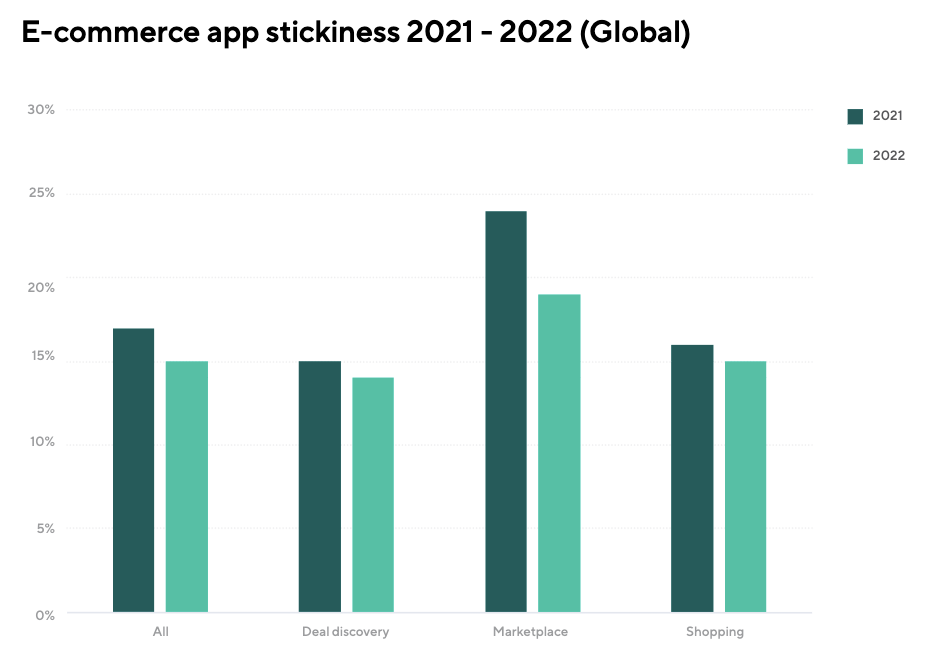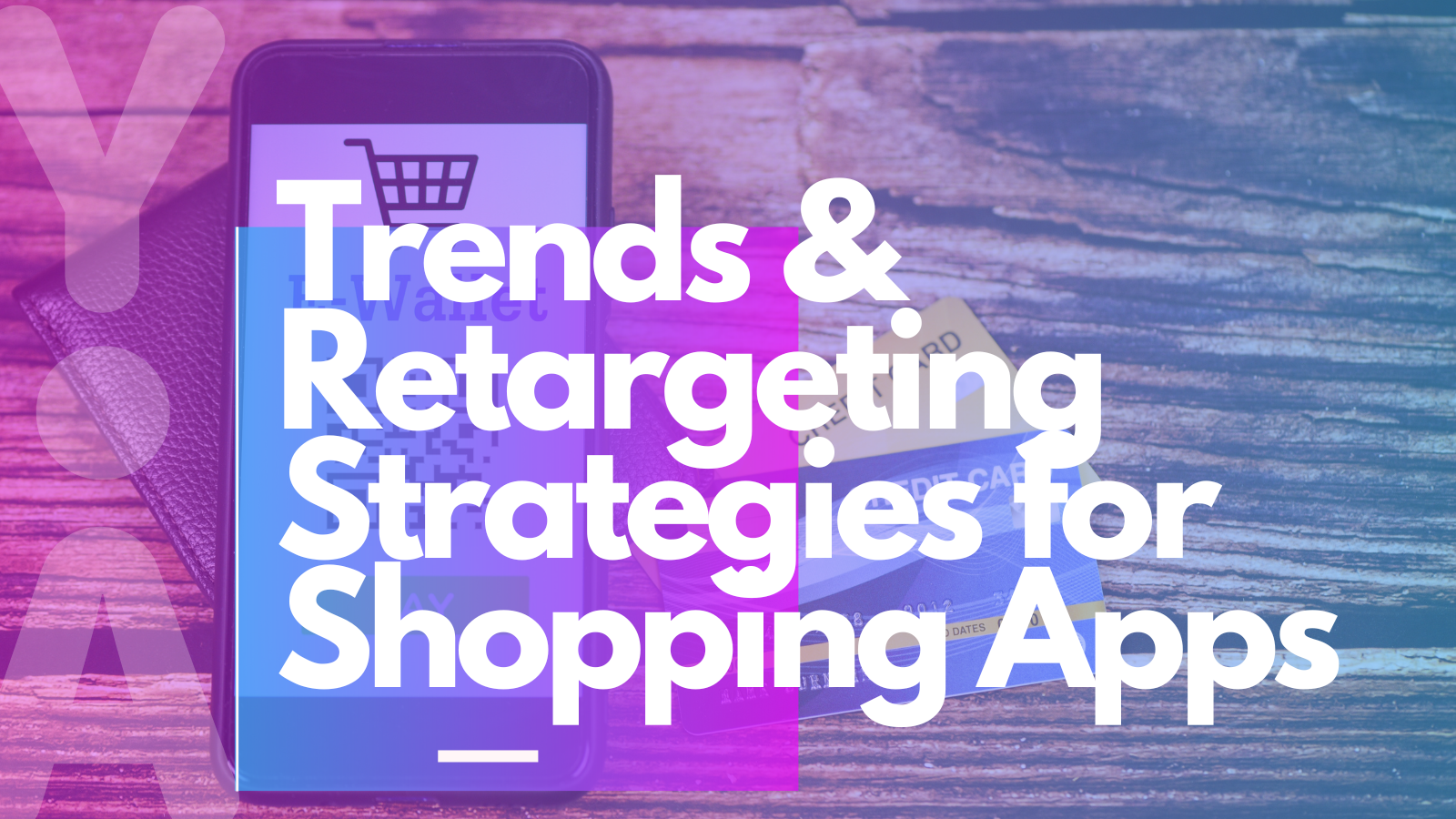As more consumers turn to their smartphones for shopping, mobile-first shopping apps have become increasingly popular. Today, more than half (53%) of consumers use their smartphones to shop. Below, learn the top shopping app trends of 2023 and key retargeting strategies to enhance your ecommerce brand’s ROI.
Shopping app trends
Global trends
The mobile commerce or “m-commerce” market is booming with sessions and session lengths both up YoY in 2022 according to Adjust. What’s more — in 2023 so far, sessions are up another 7%, from 10.57 minutes to 11.2 minutes per session. Overall, m-commerce sales in 2022 amounted to $415.93 billion. This represented 9.9% growth YoY.
According to Statista, more than two-thirds (66%) of all global ecommerce retail sales last year took place on mobile devices. In certain regions, that rate was even higher. For example, in APAC, where mobile commerce made up 80% of retail sales.
Looking forward, Insider Intelligence predicts m-commerce sales will hit $534.18 billion by 2024. This would make up 40.4% of all e-commerce sales.
Retention rates
While sessions and share of mobile sales are up, unfortunately, m-commerce retention rates decreased slightly in 2022. According to Adjust, Day 1 rates dropped from 20% to 19% and Day 14 decreased from 9% to 8%.

|
Source: Adjust
Retail app stickiness also trended down last year according to Adjust from 17% in 2021 to 15% in 2022.
* For reference: an app's retention rate measures how many users are returning to the app month after month or year after year. On the other hand, stickiness refers to how valuable a customer perceives an app to be — this can be based on the number of repeat purchases they’ve made.

|
Source: Adjust
Decreases in both retention and stickiness reflect the ever-growing importance of investing in strategies to bring customers back. Along with building excellent onboarding journeys and highly segmented user experiences, investing in retargeting campaigns to entice previous customers to re-open ecommerce apps is crucial.
Top shopping apps
While global installs of shopping apps declined slightly last year compared to 2021 (-0.6%), certain subcategories of the retail sector saw bounds. One in particular were women’s apparel apps. According to Sensor Tower, women’s apparel apps grew 13 percentage points from 2019 to Q1 2023. This remarkable level of growth shows women’s apparel to be a growing sector of the fashion market. In particular, frontrunner SHEIN, a women’s apparel app that has been a leader among fashion apps since 2019.

|
Source: Adjust
Case study: SHEIN
Not only has SHEIN led the shopping app category in downloads, it’s also led in terms of retention. According to Sensor Tower, 34% of SHEIN users open the app the day after it is downloaded. This rate drops to about 18% a week later and close to 8% 90 days after download. This far outpaces the retail category retention rates noted above.
SHEIN 1Q23 Retention

|
Source: Sensor Tower
What accounts for SHEIN’s incredible growth the last few years?
SHEIN’s high retention rate could be explained by its daily flash sales strategy. Among other top women’s apparel apps, SHEIN is the only app that offers daily flash sales. This unique feature encourages users to re-open the app daily, and creates a sense of exclusivity and urgency that sets SHEIN apart from its competitors.
Shopping app retargeting tips
As mentioned above, there are certain features all shopping app marketers should consider to keep users coming back to their app. This includes seamless onboarding journeys, hyper-personalized user experiences and frictionless purchase options like one-click checkouts. Additionally, shopping apps should be investing in retargeting campaigns to re-engage and retain users. With shopping app retention and stickiness seeing declines, investing in retargeting is more beneficial than ever.
Host flash sales and exclusive events
Taking a page from leading shopping app, SHEIN, hosting flash sales and exclusive shopping events can persuade users to consistently engage with your app. Review what your competitors are doing and craft ways to enhance exclusivity by offering new and different events. This might be inviting users to participate in a two for one purchase day every month or launching a unique brand collaboration.
Promote deals and discounts
As the economy shifts, consumers are more price conscious than ever. A great way to entice customers back to your app is to create ads that highlight cost-savings and price promotions. This might be sale items or deals that customers might not know about unless they were checking your brand’s website. Leverage copy that creates a sense of urgency with “limited time” and “offer ends soon” verbiage.
Bet big on shopping holidays
Using shopping holidays like Black Friday and Single’s Day can catapult your brand to be top-of-mind for new and existing customers. In 2022, top apps like Amazon and Taobao Tejia in China saw their biggest active user spikes on shopping holidays like Black Friday and Single’s Day according to Data.ai. Plan your retargeting campaigns well in advance of these big ticket shopping days to include fresh graphics and engaging copy. Don’t forget to craft ads to serve after shopping holidays are over to keep customers coming back.
Use segmentation to hyper-personalize ads
Personalization is one of the top ways to increase the conversion rates of your retargeting campaigns. Create ads that meet users where they are in their experience of your brand. This might be through ads that highlight abandoned shopping cart items or products that a user browsed previously. As access to a user’s IDFA can restrict the amount of data your brand can use to create hyper-personalized ads, craft a custom ATT opt-in prompt to enhance your opt-in rates.
Make ads “shoppable”
Ever see an ad on a mobile web page with a cool product that stops you in your tracks? Using dynamic creative optimization, you can show ads featuring products that align with users’ real-time browsing behavior. This might be an item they previously viewed or a product in a category they’ve been shopping for recently.
Takeaways
With shopping app retention and stickiness seeing declines, investing in retargeting is more important than ever for apps in the m-commerce vertical.
- The m-commerce market continues to grow, with sessions and session lengths increasing year-over-year. Overall m-commerce sales in 2022 amounted to $415.93 billion, representing a 9.9% growth year on year.
- Two-thirds (66%) of all global ecommerce retail sales in 2022 took place on mobile devices.
- M-commerce sales are projected to reach $534.18 billion by 2024, accounting for 40.4% of all e-commerce sales.
- Last year, m-commerce retention rates decreased from 20% to 19% on Day 1, and from 9% to 8% on Day 14. Retail app stickiness also decreased from 17% in 2021 to 15% in 2022. This indicates the ever-growing importance of investing in retargeting campaigns to keep customers coming back and making repeat purchases.
- Retargeting tips for shopping apps: Host flash sales and exclusive events, promote deals and discounts, leverage shopping holidays, use segmentation to hyper-personalize your ads and dynamic creative optimization to make ads "shoppable".
Looking for ways to enhance your shopping app’s LTV? Reach out to our team of growth experts to explore retargeting and re-engagement strategies that can enhance your brand’s growth and ROI.




